
Hancock is a city in the Upper Peninsula of the U.S. state of Michigan. The population of Hancock was 4,501 at the 2020 census. The city is located within Houghton County, and is situated upon the Keweenaw Waterway, a channel of Lake Superior that cuts across the Keweenaw Peninsula. Hancock is located across the Keweenaw Waterway from the city of Houghton, and is connected to that city by the Portage Lake Lift Bridge. The city is located within Michigan's Copper Country region.

La Porte is a census-designated place (CDP) in Plumas County, California, United States. The population was 26 at the 2010 census, down from 43 at the 2000 census. The twon was frist known as Rabbit Creek.
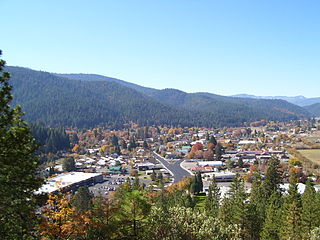
Quincy is a census-designated place and the county seat of Plumas County, California. The population was 1,630 during the 2020 Census, down from 1,728 during the 2010 Census, and 1,879 during the 2000 Census.
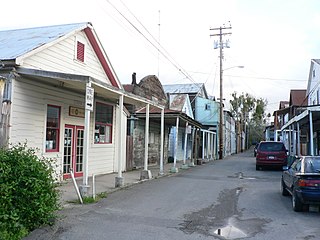
Locke, also known as Locke Historic District, is an unincorporated community in the Sacramento–San Joaquin River Delta of California, United States. The 14-acre town (5.7 ha) was first developed between 1893 and 1915 approximately one mile north of the town of Walnut Grove in Sacramento County.
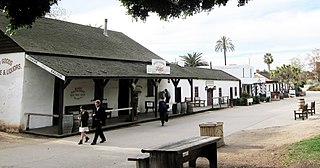
Old Town San Diego State Historic Park, located in the Old Town neighborhood of San Diego, California, is a state protected historical park in San Diego. It commemorates the early days of the City of San Diego and includes many historic buildings from the period 1820 to 1870. The park was established in 1968. In 2005 and 2006, California State Parks listed Old Town San Diego as the most visited state park in California.

State Route 49 is a north–south state highway in the U.S. state of California that passes through many historic mining communities of the 1849 California gold rush and it is known as the Golden Chain Highway. The highway's creation was lobbied by the Mother Lode Highway Association, a group of locals and historians seeking a single highway to connect many relevant locations along the Gold Rush to honor the 49ers. One of the bridges along SR 49 is named for the leader of the association, Archie Stevenot.

The Stagecoach Inn Museum in Newbury Park, California, originally known as the Grand Union Hotel, was used as a resting area for people who traveled from Los Angeles to Santa Barbara. Besides a hotel and stagecoach stop, it has also been used as a post office, church, restaurant and military school. It is California Historical Landmark No. 659 and is listed in the National Register of Historic Places. It played a major role in the development of the stage line transportation network in California. The hotel was also the first business venture in the Conejo Valley.

Elizabethtown, California was a California Gold Rush town that began in 1852 in Plumas County, California. It was named after a woman in the miners camp called Elizabeth Stark Blakesley.

Monterey State Historic Park is a historic state park in Monterey, California. It includes part or all of the Monterey Old Town Historic District, a historic district that includes 17 contributing buildings and was declared a National Historic Landmark in 1970. The grounds include California's first theatre, and the Monterey Custom House, where the American flag was first raised over California.
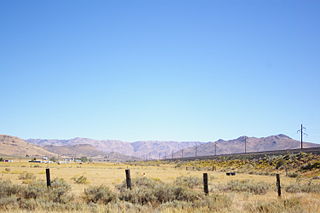
Beckwourth Pass is the lowest mountain pass in the Sierra Nevada mountain range at an elevation of 5,221 feet (1,591 m).
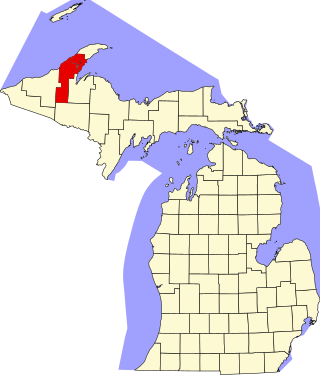
This is a list of the National Register of Historic Places listings in Houghton County, Michigan.

This is a list of the National Register of Historic Places listings in Plumas County, California.
A Mississippi Landmark is a building officially nominated by the Mississippi Department of Archives and History and approved by each county's chancery clerk. The Mississippi Landmark designation is the highest form of recognition bestowed on properties by the state of Mississippi, and designated properties are protected from changes that may alter the property's historic character. Currently there are 890 designated landmarks in the state. Mississippi Landmarks are spread out between eighty-one of Mississippi's eighty-two counties; only Issaquena County has no such landmarks.
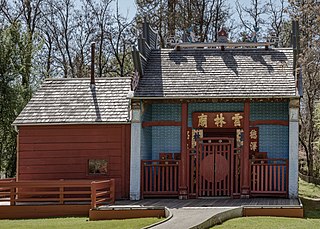
Weaverville Joss House State Historic Park is a state park located in the center of the town of Weaverville, California. The site is a Taoist temple which is still in use, and is the oldest Chinese temple in California.

The First Unitarian Church of San Jose is located at 160 North Third Street in downtown San Jose, California, across from St. James Park, and was designed in "Richardsonian Romanesque" style by architect George Page, who also designed the Hayes Mansion. Local historian Linda Larson Boston called the building, “One of a handful of American churches patterned after Unitarian churches of Transylvania, it features a large triple-arched stained glass window on the facade, multiple domes and cupolas, and both round and square towers,” in her pamphlet, Highlights of San Jose, California’s St. James Park and Environs. The congregation purchased the site in 1888, and the cornerstone was laid in a ceremony on September 23, 1891. The building is registered on both the list of National Register of Historic Places and the list of California Historical Landmarks.

The American Ranch on the Beckwourth Trail, was a 160-acre farm and lodging house located in the American Valley, now Quincy, California.
The Plumas County Museum is a 501(c)3 organization and historical museum located in Quincy, California. Exhibits focus on Plumas County, including the Maidu people, the California Gold Rush, the logging industry, and the local community.
Pioneer School House in Quincy, California was built in 1857 by the residents of Plumas County. The School served the residents of the American Valley, a plain with an elevation of 3415 feet. American Valley is near East Quincy and Quincy Junction. Quincy Junction was the interchange of the Quincy Railroad and the Union Pacific (former Western Pacific. The Pioneer School House was the first schoolhouse in Plumas County. The schoolhouse opened with 19 students with teacher Mr. S. A. Ballou. The Plumas County Museum manages the Pioneer Schoolhouse now, the Schoolhouse was moved to the Plumas Sierra County Fairgrounds. The Pioneer Schoolhouse is open during some special events and during the Plumas-Sierra Fair in August. The Pioneer School House is a California Historical Landmark No. 724, registered on January 13, 1958. In 1957 the School House was still being used, but for kindergarten classes only.


















